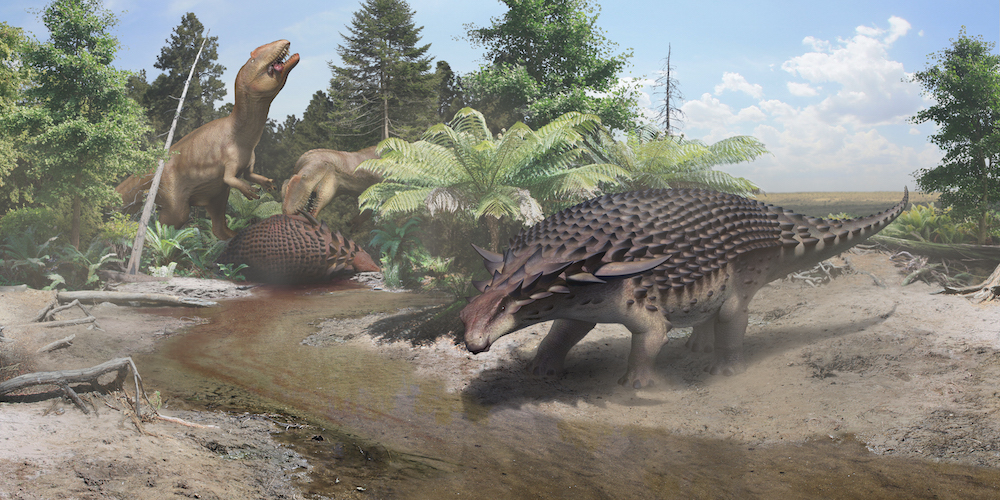'Sleeping Dragon' Dinosaur Wore Camouflage to Elude Predators
The remains of a 110-million-year-old tank-size dinosaur — so well preserved that a museum preparator said it looks like a statue of a sleeping dragon — show that this fearsome creature was covered in armor and spikes, and also used camouflage.
The dinosaur — a nodosaur, an armored relative of the ankylosaur — had a form of camouflage known as countershading, meaning it had a dark-colored backside and a light underbelly, the researchers said.
"If it was countershaded, there must have been a selective pressure for that camouflage, meaning that it was actively being hunted by visual predators," said study lead researcher Caleb Brown, a postdoctoral fellow at the Royal Tyrrell Museum of Palaeontology in Canada. "It just goes to show you how nasty, how intense the predation would have been back in the Cretaceous." [See Photos of the Nodosaur Fossil and Drawings of its Countershading]
Colorful fossil
Dinosaur lovers celebrated this past spring when Canadian paleontologists revealed they had unearthed the most complete armored dinosaur on record. The nodosaur had been discovered in an Alberta mine in March 2011.
The researchers named the 18-foot-long (5.5 meters) dinosaur Borealopelta markmitchelli: the genus name means "northern shield," as "borealis" is Latin for "northern" and "pelta" is Greek for "shield." The species name honors Royal Tyrrell Museum technician Mark Mitchell, who spent more than 7,000 hours (about 5.5 years) revealing the delicate fossil and covering it with glue to preserve it.
Mitchell's careful preparation unveiled a black sheath covering parts of the 3,000-lb. (1,360 kilogram) specimen. This sheath, researchers suspected, contained remnants of the dinosaur's skin.
After joining forces with study co-researcher Jakob Vinther, a molecular paleobiologist at the University of Bristol in the United Kingdom, the researchers used a geochemical analysis to find that the black film had a byproduct of pheomelanin, a reddish pigment that gives redheads their hair color.
Get the world’s most fascinating discoveries delivered straight to your inbox.
This byproduct indicates that B. markmitchelli was a brownish-red. But because the herbivore's skin had degraded due to heat, time and pressure, its remnants have since melted into sludge, Brown said.
"But we can see that there's more concentrations of this organic material on the back of the animal, and as we transition toward the belly, it becomes less and less common and eventually disappears," Brown said. This pattern suggests the dinosaur had countershading, he said.
Countershading "is incredibly common today as a form of camouflage," and is seen, for example, in deer, gazelles and sharks. In contrast, larger animals, such as elephants, rhinos and bison, don't have countershading, likely because they have few predators.
Perhaps this nodosaur's countershading helped it hide from huge predators, such as the tyrannosaur Acrocanthosaurus, Brown said.
B. markmitchelli isn't the only dinosaur on record with known countershading: Psittacosaurus, a 120-million-year-old Triceratops relative, also had a dark-colored backside and a light underside, according to a 2016 study in the journal Current Biology.
The new study was published online today (Aug. 3) in the journal Current Biology.
Original article on Live Science.

Laura is the managing editor at Live Science. She also runs the archaeology section and the Life's Little Mysteries series. Her work has appeared in The New York Times, Scholastic, Popular Science and Spectrum, a site on autism research. She has won multiple awards from the Society of Professional Journalists and the Washington Newspaper Publishers Association for her reporting at a weekly newspaper near Seattle. Laura holds a bachelor's degree in English literature and psychology from Washington University in St. Louis and a master's degree in science writing from NYU.
 Live Science Plus
Live Science Plus







